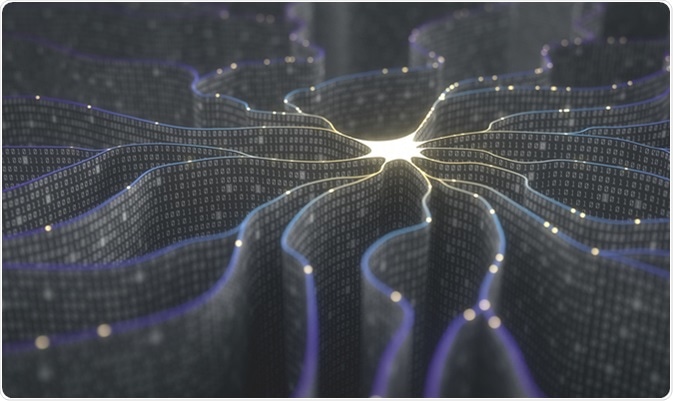Artificial intelligence, or AI, constitutes machine learning and deep learning, which enables computers to learn without being explicitly programmed every step of the way.
This type of technology has shown to be very useful in life science industries, such as by sorting different types of cancer cells in laboratories. Naturally, technology, which both serves a function, and removes the need for explicit programming, will affect a host of jobs in the life science industry.

3D illustration. Artificial neuron in concept of artificial intelligence. Image Credit: Ktsdesign / Shutterstock
Artificial Intelligence
There are several types of machine learning and deep learning, which are subcategories of AI. The basic principle dictates that AI is machine intelligence leading to the best outcome when given a problem. This sets up AI well for life science applications – AI can be taught to differentiate cells, be used for higher quality imaging techniques, and analysis of genomic data.
Deep learning is a favorite among the AI facets in biology. The structure of deep learning has its roots in the structure of the human brain, in that there are neural networks, which connect to one another through which the data is passed. At each layer, some data is extracted. For example, in cells, one layer may analyze cell membrane, the next some organelle, and so on until the cell can be identified.
The Intelligence Revolution: Coupling AI and the Human Brain | Ed Boyden | Big Think
In classic machine learning, data often required some conversion or manipulation into a more meaningful form, such as features or connections before it could be exposed to the machine learning model. With deep learning, this is not required. Genomic data, which entails a huge number of bases to be analyzed, can be fed directly to the deep learning model, where the computer has to find the meaningful features or relationships. While the AI then removes one job of analyzing genomic data, it also creates a new one – researchers are not in charge of the classification and cannot explain why the model predicts the way it does. This uncertainty in how the model works, opens the opportunity for researchers to find out why the machine learning system, for example, picked one gene over another.
Transforming the Life Sciences Through AI-Powered Search
Applications and Jobs
Image analysis is one field of life science that is being affected by AI. While automatic imaging software has existed without AI, the addition of deep learning has allowed software to use several features, which may not initially be obvious.
For example, the software CellProfiler incorporates deep learning to measure features, such as texture of organelles and quality of empty spaces in a cell. In such cases, the jobs normally done by scientists in measuring cell characteristics can be done by an automated AI software. However, by measuring unusual characteristics the AI can pick up on more untapped information.
Genomes are a natural fit for AI, because they often consist of massive datasets, which require a lot of annotation and work. Existing software requires well annotated genomes, and because of this much of our understanding centers around more popular organisms. Using deep learning, a software called DeepVariant can identify single nucleotide polymorphisms by transforming genomic information into images. These images represent the different nucleotides, and can be used by the model to identify polymorphisms. This method makes it possible for researchers outside of the mainstream to use, because more uncommon model organisms can be studied. This removes significant amount of work by researchers on improving low quality reference genomes, and the high error rate otherwise associated.
All in all, while the need for cell image analysts and scientists working to improve genome annotation reduces, there is an increased desire for a special branch of scientists. These are computational biologists, who have been behind the two mentioned software. They face increasing employment opportunities as more life science professionals seek to apply AI to their laboratories. While AIs are capable of outperforming human scientists in several areas, they are more likely to take over certain tasks rather than the jobs of life science professionals.
Further Reading
Last Updated: Oct 29, 2018